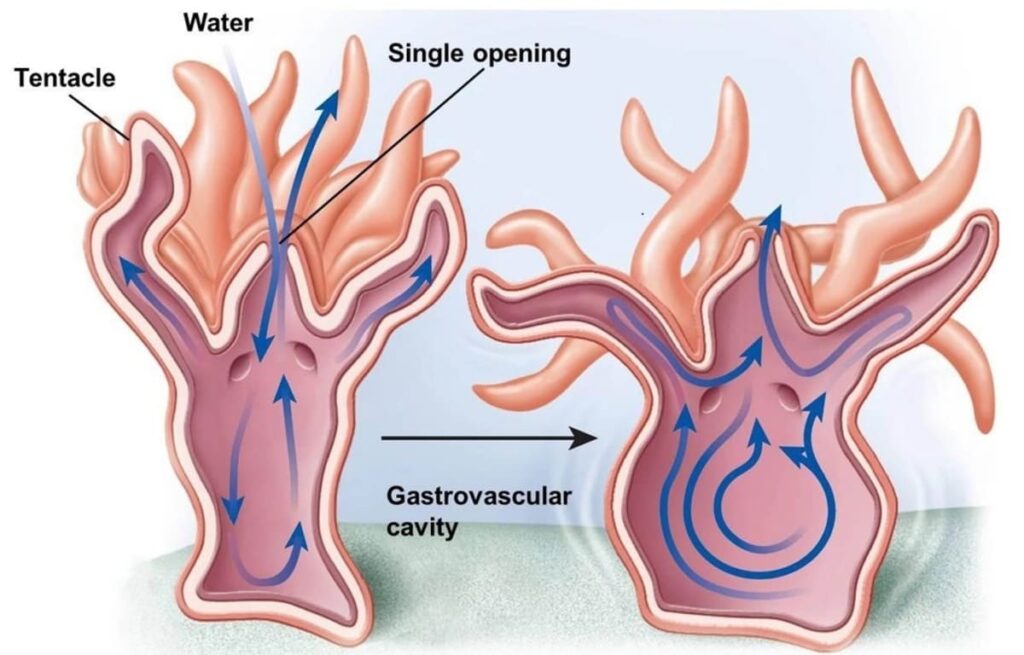A new world awaits you once you put on your diving goggles, insert the snorkel into your mouth, and dive underwater. I had many opportunities to explore this mysterious place while living in the Caribbean for a half year. Coral reefs, with their vibrant colours and diverse fish, have always struck me as particularly beautiful. In this blog post I want to figure out what makes this ecosystem so special. So, let´s explore the importance of coral reefs together.
What are corals?
Let´s start with the basics. Corals belong to a large group of invertebrate animals, the Cnidaria, of which jellyfish and sea anemones are also part. Cnidarians come in a wide range of shapes, sizes and colours. What they have in common is their simple stomach, called the gastrovascular cavity, which opens in a mouth, surrounded by tentacles. 1

Gastrovascular cavity of Cnidaria (Google Create Commons, s.a.)
Most Cnidaria have two types of live states: A fixed and a loose one. Corals, on the other hand, only exist in the fixed form, known as a polyp. Many corals live in colonies of polyps. The colony is formed when a polyp grows and copies itself. A form of asexual reproduction, which makes a colony of polyps genetically identical. 1
What is a coral reef made of?
You can distinguish between, hard and soft corals. 1 Stony corals (scleractinians), which are hard corals, are mainly responsible for building reef structures. Each individual stony coral builds a carbonate skeleton to form together massive reef structures. 2 Hard corals include brain corals, which, as the name implies, look astonishingly similar to human brains.

Soft corals don’t have a calcareous skeleton. They include sea fans and sea whips and have a wooden core for protection. 1
Biodiversity of Coral Reefs
Coral reefs are home to approximately 25% of all marine species, even though they occupy only one per cent of the ocean floor. 3 They are one of the world’s most diverse inhabitants. Coral reefs function as nurseries to a variety of fish species and protect small fish. 4
What makes coral reef biodiversity so important? An ecosystem with many different species is more resilient to disturbances. 3 This makes sense when considering that species that can adapt to this specific disturbance are more likely to be found in a more diverse ecosystem. In a system with only a few species, it is possible that none of them can cope with changing environmental conditions.
Ecosystem services Coral Reefs provide
In addition to their value to marine organisms and intact ecosystems, coral reefs provide a variety of ecosystem services. Economic evaluation can translate these societal benefits. On average coral reefs have an ecosystem value of 352,249 Dollar/ha/Year, considering their most important ecosystem services such as regulating and supporting. 5
The term “regulating and supporting function” refers to how coral reefs help to protect coastal areas from storms by attenuating wave action, or how they stabilize soil and thus control erosion. Because of their nutrient uptake and recycling, coral reefs also purify water. Furthermore, they sequester carbon by promoting the accumulation of organic matter. Coral reefs hold significant importance for both recreation and tourism, providing opportunities for people to learn about marine life. 5
Conclusion
Coral reefs are a type of ecosystem made up of invertebrate animals called Cnidaria, which includes polyps that form colonies. They are important for their high biodiversity, serving as a home for 25% of marine species and functioning as a nursery for various fish species. The importance of coral reefs also lies in their ecosystem services, including their ability to regulate and support coastal areas, purify water, sequester carbon, and provide economic value. Maintaining the biodiversity of coral reefs is crucial for their resilience to environmental disturbances, as a diverse ecosystem is more likely to have species that can adapt to changes.
In my next post, i´ll target a topic, which is rather sad but important. I want to talk about how coral reefs are affected by climate change.
References:- International Coral Reef Initiative, 2021. What are corals? Available at: https://icriforum.org/about-coral-reefs/what-are-corals/ [9.02.2023].
- National Ocean Service, 2013. What is a coral reef made of? Available at: https://oceanservice.noaa.gov/facts/coralmadeof.html [9.02.2023].
- Coral Reef Aliance, s.a. Biodiversity. Available at: https://coral.org/en/coral-reefs-101/why-care-about-reefs/biodiversity/ [6.02.2023].
- National Geographic, s.a. Coral Reefs. Available at: https://education.nationalgeographic.org/resource/coral-reefs [6.02.2023].
- Milon, J.W.; Alvarez, S.; The Elusive Quest for Valuation of Coastal and Marine Ecosystem Services. Coastal Resources Economics and Ecosystem Valuation 2019, 2, 5-23.

 To provide scientific knowledge on this site for free means a lot to me. However, researching and writing costs me a lot of time. Since I´m a student, financial support for my blog post helps me to maintain scientific quality.
To provide scientific knowledge on this site for free means a lot to me. However, researching and writing costs me a lot of time. Since I´m a student, financial support for my blog post helps me to maintain scientific quality.